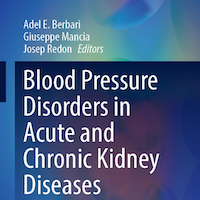Tag: AKI
Seraph-100 Hemoperfusion: Clearing Pathogens and Enhancing Outcomes in Sepsis
This study evaluated Seraph-100 hemoperfusion (HP) as a treatment for sepsis in intensive care unit (ICU) patients admitted after cardiac surgery for infective endocarditis (IE). Thirteen septic patients received Seraph-100... read more
Hemolysis in Septic Patients with Acute Respiratory Failure: Prognostic Implications
This study highlights the critical role of hemolysis in sepsis and acute respiratory failure, showing a strong association with organ dysfunction. Hemolysis is notably frequent, especially in patients with septic shock... read more
Hemodynamic Stabilization Using CRRT and cIVNa Combination Therapy
Compared with conventional continuous renal replacement therapy (CRRT), combination therapy of CRRT and continuous intravenous sodium infusion therapy (cIVNa) increased blood pressure, enhanced urinary volume, and reduced... read more
Aminoglycosides Impact on Survival Rate and Renal Outcomes in Patients with Urosepsis
The addition of aminoglycosides to beta-lactam therapy in critically ill patients with urosepsis did not significantly improve 30-day survival. Furthermore, aminoglycosides were not associated with worse renal outcomes.... read more
Management of ARDS COVID-19 Patients Using Hemoperfusion and CRRT
Combined hemoperfusion (HP) and continuous renal replacement therapy (CRRT) hold promise as a potential intervention for severe COVID-19 cases with multiple organ dysfunction, leading to improved clinical outcomes. Fifty-six... read more
Mortality in Patients with SA-AKI Using the MIMIC-III Database
In this study, we identified critical factors influencing mortality in patients with Sepsis-Induced Acute Kidney Injury (SA-AKI) using the MIMIC-III database. The primary findings of our research, including advanced age,... read more
Blood Pressure Disorders in Acute and Chronic Kidney Diseases (Updates in Hypertension and Cardiovascular Protection)
This new book is intended to be an in-depth and up-to-date guide to the various aspects of the association between blood pressure disorders and acute/chronic renal diseases. In addition, this work includes discussion... read more

Peritoneal Dialysis in AKI: 20 Years of Experience at a Single Center
Peritoneal dialysis (PD) may be an effective solution for acute kidney injury (AKI) patients, allowing adequate metabolic and fluid control. Age, APACHE score, hepatorenal syndrome and dropout from PD were associated... read more
Major Cardiovascular Surgery-induced Metabolic Reprogramming Role in AKI
Major cardiovascular surgery, particularly with cardiopulmonary bypass (CPB), induces significant changes in protein metabolism. Patients developing postoperative acute kidney injury (AKI) exhibited specific metabolic signatures.... read more
Association Between Osteopontin and Apolipoprotein E gene Polymorphisms and Vancomycin-induced AKI
Individuals carrying specific genotypes of APOE (e2e3) were more prone to develop vancomycin-induced acute kidney injury (AKI), per se. This could apply to other nephrotoxic agents as well. We also observed a significant... read more
Lactate Trajectory Models for Predicting AKI and Mortality in Hyperlactatemia Patients
The present study underscores the significant prognostic value of lactate trajectories in critically ill patients, particularly those with hyperlactatemia. Our findings suggest that rapid lactate clearance is strongly... read more
Clinical Prediction Model Development for Stages of AKI in Critically Ill Patients
Using readily available predictors in the ICU setting, we could develop a prediction model for different stages of AKI with good performance and promising clinical usefulness. Among critically ill patients, acute kidney... read more
Hemoglobin Glycation Index vs. Adverse Outcomes in Critically Ill Patients with Myocardial Infarction
Based on the MIMIC-IV database, this study found that lower HGI is significantly associated with an increased risk of short-, mid- and long-term all-cause mortality in critically ill myocardial infarction (MI) patients. As... read more
Association Between Aspirin and AKI in Critical Patients with Chest Trauma
This analysis of two datasets reveals that aspirin usage is associated with an increased risk of acute kidney injury (AKI) in critical patients with chest trauma; however, no significant association was observed between the... read more
Predicting SA-AKI Mortality Using XGBoost Algorithm
The integration of advanced techniques with the XGBoost algorithm yielded a highly accurate and interpretable model for predicting Sepsis-Associated Acute Kidney Injury (SA-AKI) mortality across diverse populations. It... read more
Clinical Efficacy of Nafamostat Mesylate-assisted CRRT Therapy in SA-AKI Patients
Nafamostat Mesylate (NM)-assisted continuous renal replacement therapy (CRRT) therapy significantly improves the therapeutic efficacy of patients with sepsis-associated acute kidney injury (SA-AKI). This combined approach... read more
Pre-ICU Statin Use, AKI and in Hospital Mortality in Sepsis Patients
Pre-ICU statin therapy is associated with a lower risk of acute kidney injury (AKI), and improved in-hospital survival among obese patients with sepsis, suggesting its potential role as a protective measure in this high-risk... read more
Diastolic Dysfunction Increases AKI Rick in COVID-19 Patients
Diastolic dysfunction increases the risk of acute kidney injury (AKI) in patients with severe COVID-19. Using point-of-care ultrasound (PoCUS) to assess left ventricular diastolic function in the ICU may be a useful parameter... read more
Dynamic Nomogram for AKI Prediction in ICU Patients with AHF
After strict screening, 1338 patients with acute heart failure (AHF) were included in the derivation set, and 3,129 in the validation set. Sepsis, use of human albumin, age, mechanical ventilation, aminoglycoside administration,... read more
Association Between the Lactate-to-Albumin Ratio (LAR) Index and AKI Risk in Critically Ill Patients with Sepsis
Lactate-to-albumin ratio (LAR) is an emergency predictive indicator of sepsis-related mortality. An elevated LAR is associated with poor outcomes in critically ill patients. However, its predictive value for acute kidney... read more
AKI and Mortality Predictors of Systemic Autoimmune Diseases and COVID-19
The present study highlights renal parameters and outcomes associated with various systemic autoimmune diseases and COVID-19. Patients who presented with low oxygen saturation (... read more
Zosyn vs. Efepime: Which One Is Safer?
While both piperacillin-tazobactam and cefepime are commonly used to treat infections caused by Pseudomonas aeruginosa in hospitalized patients, there is a concern that piperacillin-tazobactam may lead to acute kidney injury... read more









